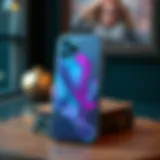Exploring the Versatile Applications of UV Bandanas

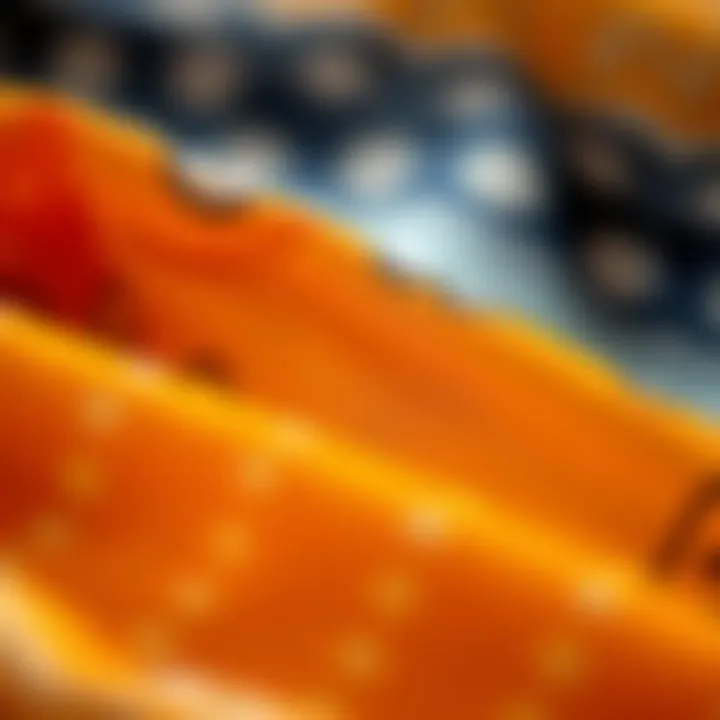
Intro
In the ever-evolving landscape of fashion, UV bandanas have carved out a unique niche. These practical yet stylish accessories are gaining popularity not only for their aesthetic appeal but also for their innovative fabric technology that offers protection against harmful ultraviolet rays. With more individuals becoming aware of the risks posed by sun exposure, bandanas designed specifically for UV protection are emerging as a game changer in the way we think about style and functionality.
It’s no wonder that UV bandanas are being embraced across various demographics, from outdoor enthusiasts seeking sun protection during their adventures to city dwellers looking for a trendy addition to their outfits. The intersection of fashion and safety is no longer tenuous; instead, it’s a lifestyle choice that merges sleek design with necessary safeguard. As we delve into this topic, we’ll unpack essential fashion trends, practical applications, and the sophisticated material properties of these multifaceted accessories.
Understanding UV Protection
Understanding UV protection is essential for both health and fashion, especially when it comes to accessories like UV bandanas. These items not only accentuate personal style but also serve a practical purpose. With rising awareness around sun safety, it's vital for consumers to grasp the mechanisms behind UV rays and the protective measures they can adopt. Proper knowledge around UV protection empowers individuals to make informed choices that can impact their skin health and overall well-being.
The Science Behind UV Rays
Ultraviolet (UV) rays are a form of electromagnetic radiation emitted by the sun. They are categorized into three types: UVA, UVB, and UVC. UVA rays can penetrate deeply into the skin and contribute to age spots and wrinkles. Conversely, UVB rays are mainly responsible for sunburns and can lead to skin cancer. UVC rays, while the most harmful, are absorbed by the Earth's atmosphere and do not reach the ground.
A common misconception is that you only need protection on sunny days. UV rays can penetrate through clouds, and their strength can vary based on the season, location, and altitude. For instance, someone hiking in the mountains might face higher UV exposure due to the thinner atmosphere.
Understanding the nature of these rays helps individuals realize the importance of protective gear, including UV bandanas. In addition to the traditional sunscreen, these accessories can offer a significant barrier against harmful radiation.
Health Risks Associated with UV Exposure
Excessive exposure to UV rays can lead to a host of health issues. Skin cancer is the most notorious risk, with melanoma being the deadliest form. Furthermore, prolonged sun exposure can cause cataracts, compromising eye health.
The skin response to UV radiation varies from person to person. Some individuals might burn easily, while others might tan without much consequence. However, irrespective of skin type, it’s crucial to adopt sun protection strategies. For instance, using UV bandanas and applying broad-spectrum sunscreen are effective ways to minimize risks.
In today’s fast-paced lifestyle, many overlook the need for consistent UV protection. An easy yet impactful change is incorporating UV-protective apparel, such as bandanas, into daily routines.
UV Protection Ratings Explained
When considering UV protection, look at the Ultraviolet Protection Factor (UPF) rating. This number indicates the level of UV radiation that can penetrate the fabric. For example, a UPF of 50 means that only 1/50th of the UV rays can pass through, offering excellent protection.
The ratings can range from a UPF of 15 to 50+. Fabrics with a UPF of 15 to 24 offer good protection, while those rated 25 to 39 provide very good protection. Anything above 40 falls into the excellent category. It's worth noting that the color, density, and elasticity of the fabric can also influence the UPF rating. Darker colors and tightly woven materials typically offer better protection than lighter or loosely woven alternatives.
For shoppers, understanding these ratings is crucial when selecting UV bandanas, ensuring that style never compromises safety. Incorporating this knowledge not only enhances fashion choices but also nurtures one’s health in the long run.
"In corporate language, it’s the risk that often takes a backseat until it’s too late; but prevention is always better than cure."
By guiding consumers through the nuances of UV protection, brands can effectively communicate the importance of UV bandanas as both fashionable and functional wear.
Prelims to UV Bandanas
The modern world brims with concerns about wellness and personal style, making UV bandanas a noteworthy subject. They serve not only as a practical accessory but also integrate seamlessly into fashion trends. With increasing awareness of the harmful effects of UV rays, the need for protective gear that also complements one’s appearance has emerged as a priority for many.
What Are UV Bandanas?
UV bandanas are versatile neck coverings blended with advanced fabric technology designed to block ultraviolet rays from the sun. These accessories are typically made from breathable materials that not only protect against sun exposure but also allow for comfort in various climates. Unlike traditional bandanas that primarily serve aesthetics, UV bandanas incorporate specific properties aimed at safeguarding the skin, making them practical yet stylish options for outdoor enthusiasts.
Some common materials include polyester and nylon treated with UV-blocking agents, ensuring that UV bandanas offer much more than mere decoration. An added benefit is their flexibility; they can be worn in different styles, from neck gaiters to headbands, catering to personal preferences while providing maximum protection.
Historical Perspective on Bandanas
The bandana phenomenon dates back centuries, with roots in various cultures across the globe. Originally, these fabric squares were used for practical purposes: sweat-wicking, protection against dust, and even as makeshift pocket squares. Primarily crafted from cotton, their colors and patterns often held significance, telling stories of cultural heritage.
As time went on, bandanas took on a fashionable flair, particularly in the 1960s and 70s when they became symbols of rebellion and individuality. Today, the evolution of bandanas into UV bandanas indicates a shift in consumer needs—a blend of functionality and fashion informed by an increasing focus on health and safety.
The Rising Trend of UV Bandanas
As society becomes more health-conscious, the demand for UV bandanas is rising. Social media has played a pivotal role in this trend. Platforms like Instagram and TikTok have turned these accessories into must-have items for influencers and ordinary persons alike.
A noticeable shift can be attributed to outdoor sports growing in popularity. Activities ranging from hiking to cycling frequently involve prolonged sun exposure, increasing awareness about the importance of skin protection. Moreover, seasonal shifts also see rising interest, as families look for effective ways to enjoy their summer outings while keeping safe from harmful rays.
Consequently, companies are not only producing UV bandanas in a rainbow of colors but also infusing them with unique patterns and textures that cater to diverse tastes.
"UV bandanas are not just protective gear; they're a canvas for expression, merging style with safety in today’s sun-conscious world."
In summary, the introduction of UV bandanas into the public consciousness intertwines health, fashion, and personal expression. They are helping individuals navigate the complex landscape of maintaining both safety and style in the sunlight.
Manufacturing and Material Technology
Manufacturing and material technology play a crucial role in the effectiveness, aesthetics, and functionality of UV bandanas. As consumer awareness about sun protection grows, the emphasis on high-quality materials and the latest manufacturing methods cannot be overstated. This section addresses the significance of these elements in ensuring that UV bandanas not only protect from harmful UV rays but also cater to the demands of the modern user in various contexts.
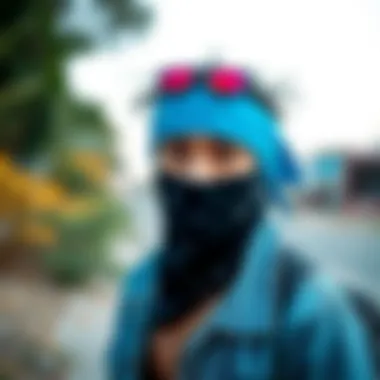

Fabrics Used in UV Bandanas
The fabrics utilized in UV bandanas can significantly alter their performance and feel. Common materials include polyester, nylon, and spandex, each contributing unique properties to the bandanas.
- Polyester: This synthetic fiber is lightweight and often treated for enhanced UV protection. It's breathable, which is essential for outdoor activities.
- Nylon: Known for its durability, nylon can withstand wear and tear, making it a fantastic choice for those engaged in active sports.
- Spandex: Often blended with other materials, spandex provides stretchability, making it comfortable and easy to fit.
Each fabric presents its benefits. For instance, some manufacturers apply specific coatings during production to improve the UV protection factor (UPF), ensuring a higher level of defense against the sun. This kind of innovation is essential for keeping consumers not just stylish but safe. However, when selecting a fabric, it is also critical to consider how it interacts with skin. For example, cotton may feel cool but often lacks the necessary UPF rating, thus making it less effective in sun protection compared to its synthetic counterparts.
Advanced Weaving Techniques for UV Protection
The weaving techniques implemented in the production of UV bandanas represent a noteworthy frontier in textile technology. Advanced methods can create tighter weaves that block more UV radiation, which is pivotal for outdoor usage.
- Tightly woven fabric is more effective at blocking ultraviolet rays compared to looser weaves. This creates a barrier that reduces the UV radiation reaching the skin.
- Specialized knitting patterns can also contribute to the overall breathability of the textile, allowing sweat to evaporate without compromising protection.
Some companies have started incorporating reflective materials in the weave, adding an additional layer of defense. This is especially useful for outdoor enthusiasts and those working in sun-intensive environments. Furthermore, developments in UV-reactive threads that change color or pattern in the sunlight have emerged, providing a dual benefit of fashion and function. Adopting such technologies not only enhances the protective qualities of the fabric but also elevates the style quotient, catering to a growing consumer desire for apparel that combines aesthetics with practicality.
Durability and Care of UV Bandanas
Just as important as the fabric and weaving techniques are the durability and care requirements of UV bandanas. Consumers seeking long-lasting products must understand how to maintain the effectiveness of the UV protection embodied in these accessories.
- Durability: The lifespan of a UV bandana can be significantly affected by its production quality. Products crafted from high-grade materials tend to withstand the rigors of frequent washing and exposure to the elements better than those made from inferior fabrics.
- Care Instructions: It's vital for users to follow care guidelines. Washing UV bandanas in cold water, using non-chlorine bleach, and avoiding high heat for drying can help maintain their structural integrity and UV properties over time.
Moreover, exposing bandanas to strong detergents or fabric softener can diminish their UV protection over repeated wash cycles. Investing in a UV bandana means considering both its initial cost and the ongoing care it requires to retain its benefits. Thus, smart consumer choices lead to longer-lasting protection, blending both fashion needs and functional demands into a cohesive accessory.
"Choosing the right fabric coupled with advanced weaving technology can substantially enhance the effectiveness of UV bandanas, offering critical protection while maintaining a stylish appearance."
Practical Applications of UV Bandanas
Understanding how UV bandanas fit into daily life is crucial, not just from a fashion perspective, but also for their health benefits. The potential of these versatile accessories is broad, touching upon various activities and settings where their utility can’t be overstated. This exploration highlights the specific applications of UV bandanas, detailing the advantages they provide in outdoor activities, everyday fashion, and occupational settings.
Outdoor Activities and Sports
Engaging in outdoor activities requires appropriate gear, and UV bandanas excel in this arena. Whether you’re hiking up rugged trails or lounging on a sandy beach, the protective qualities of these bandanas come into play. They shield the neck and face from harmful UV rays, minimizing the risk of sunburn which can ruin a perfect day outside.
In sports, versatility stands out. Cyclists might wear them as face coverings to guard against wind and sun, while runners twist and tie them to keep sweat at bay, all without compromising comfort. When the sun’s beating down, having a UV bandana can be akin to carrying your own personal shade.
Moreover, while participating in team sports like soccer or volleyball, wearing a stylized UV bandana can enhance team spirit, contributing to a unified appearance. The integration of vibrant colors and designs caters to different team identities, making functionality fashionable.
Fashion Statement in Everyday Wear
UV bandanas have carved out a niche in everyday fashion. They serve not just as sunscreens but also as chic accessories that can elevate any outfit. From the farmer's market stroll to brunch with friends, these bandanas embody a blend of style and function.
Their adaptability is noteworthy. You can loop them around your neck, wear them in your hair, or even drape them over a bag. This flexibility allows for personal expression—selecting patterns and colors that match or contrast with one’s attire can reflect individual taste seamlessly. In recent years, influencers on platforms like Instagram and TikTok have played a significant role in shaping their fashion status, showcasing creative ways to style UV bandanas.
The modern consumer increasingly values the marriage of style and safety, leading to new trends where UV protection is not simply an afterthought. The brightness of a bandana can dazzle just as much as its protective worth, making it a beloved staple in fashion circles.
Occupational Use in Sun-Intensive Jobs
For those working in jobs exposed to relentless sun—like construction, agriculture, or landscaping—UV bandanas become essential tools. Professionals facing long hours outdoors require effective sun protection strategies, and here, UV bandanas shine.
Not only do they provide physical barriers against ultraviolet rays, but they also help with thermal regulation. This is important especially in physically demanding jobs where overheating can pose health risks. A bandana worn around the neck can wick sweat away, promoting comfort while working under the sun.
Additionally, the practicality of these bandanas can lead to enhanced productivity. Workers might find that wearing a UV bandana allows them to focus on their tasks without the constant distraction of discomfort from sun exposure. Safety regulations often underscore the importance of staying cool and protected, making UV bandanas a smart choice for employers looking out for their staff's well-being.
Key Insight: UV bandanas offer a blend of style and significant sun protection, making them indispensable across various applications—from leisure to essential work settings.
Style Versatility of UV Bandanas
In the ever-evolving world of fashion, UV bandanas have carved a niche for themselves through their impressive style versatility. This section aims to showcase how these accessories not only protect from harmful UV rays but also serve as a canvas for personal expression. They embody a unique combination of functionality and aesthetics, giving them an edge in a crowded market.
Variety of Styles and Colors
The spectrum of styles and colors available in UV bandanas is nearly limitless. From vibrant florals that pop in summer sunlight to muted, earth-tone patterns ideal for a more understated look, the options cater to a variety of tastes. This variety enables users to easily choose a bandana that complements their outfit or showcases their personality.
- Floral Patterns: Perfect for spring and summer, these bandanas exude a sense of freshness.
- Stripes and Geometrics: These designs add a modern twist, appealing to minimalists.
- Solid Colors: A staple in any wardrobe, they can be easily paired with almost any attire.
"The ability of a simple piece of fabric to transform an outfit is nothing short of remarkable."
Whether it's a bright print for a sun-soaked day at the beach or a dark, subdued color for a night out, the style versatility of UV bandanas allows for endless possibilities. Such diversity encourages individuals to feel confident in their fashion choices while ensuring they’re protected against harmful UV exposure.


Adjusting to Personal Fashion Tastes
People's tastes in fashion are as varied as can be. UV bandanas offer great adaptability, allowing wearers to incorporate them according to their individual style. For those inclined towards a bohemian vibe, accessories like beaded bracelets and layered necklaces naturally pair well with a flowing, patterned bandana. Conversely, individuals who prefer a more sporty look can opt for solid or striped UV bandanas, matching them with athletic gear for hikes or outdoor activities.
Moreover, the way a bandana is worn also reflects personal style. Tying it around the neck may evoke a classic or vintage feel, while wearing it as a headband can channel a more carefree, adventurous spirit. Whether it's around the wrist or tied to a bag, UV bandanas present an opportunity to experiment and adjust to one's fashion likes.
Layering Techniques with UV Bandanas
Effective layering is an art form in fashion, and UV bandanas lend themselves well to this practice. They can be seamlessly integrated into layered outfits, adding depth and visual interest without overpowering the ensemble. Here are a few techniques worth considering:
- Worn as a Neck Scarf: Perfect under a jacket or over a simple tee, it adds an effortless chic element.
- Head Wraps: A practical and stylish choice, especially in warm weather, it protects hair and skin while looking fashionable.
- Belted around the Waist: A unique way to accessorize and accentuate the waistline, providing both style and an edgy twist to basic clothing.
Through these layering techniques, UV bandanas can enhance the overall aesthetic of an outfit, transforming even the simplest attire into something noteworthy. By effortlessly adjusting these accessories, individuals reinforce their unique style while enjoying the benefits of added sun protection.
In summary, the style versatility of UV bandanas cannot be understated. Their wide range of styles and colors, adaptability to personal tastes, and effective integration into layered outfits make them an essential accessory for modern wardrobes. Fashion enthusiasts and casual wearers alike can benefit from incorporating UV bandanas into their styles, ensuring a blend of safety and self-expression.
Sustainability and Ethical Considerations
The conversation surrounding sustainability has shifted from being an afterthought to a central tenet in fashion and accessory design. When it comes to UV bandanas, incorporating eco-friendly elements isn’t just a trend; it’s a crucial consideration for both consumers and manufacturers alike. The very fabric of these bandanas often holds stories of innovative technology and ethical responsibility, emphasizing how style does not have to compromise the health of our planet.
Sustainability in this context revolves around the materials used, the manufacturing processes, and the choices consumers make. By focusing on specific elements, this section will elucidate why sustainable practices matter in the realm of UV bandanas.
Eco-Friendly Materials in UV Bandanas
The materials that go into producing UV bandanas play an essential role in their environmental impact. Many brands are now harnessing the benefits of organic cotton, recycled polyester, and other biodegradable substances to ensure that their products align with eco-conscious standards.
Organic cotton, grown without pesticides or harmful chemicals, offers a safer alternative for both farmers and consumers. This method not only reduces pollution but also conserves water, a vital resource in an increasingly parched world. On the other hand, fabrics made from recycled materials help to minimize waste, turning plastic bottles and other discarded items into stylish and functional accessories. The result is a bandana that shields you from UV rays while also protecting the environment.
Here’s a quick glance into the common eco-friendly materials:
- Organic Cotton: Grown without synthetic fertilizers or pesticides.
- Recycled Polyester: Made from post-consumer plastic, reducing landfill waste.
- Tencel: Produced from wood pulp, using a closed-loop process that minimizes waste.
Sustainable Manufacturing Practices
Sustainable materials alone are not enough; the processes utilized in crafting UV bandanas must also be eco-friendly. Many manufacturers are now adopting practices aimed at reducing their carbon footprint. These include minimizing energy consumption during production, choosing renewable energy sources, and ensuring ethical labor practices.
Techniques like digital printing, which uses less water and fewer chemicals than traditional methods, have become popular. The focus is on creating high-quality, durable products that promote longevity over fast fashion. By making choices that emphasize sustainability, brands can foster loyalty among environmentally conscious consumers who prioritize what their purchases contribute to the wider world.
Some notable sustainable practices can include:
- Energy-efficient machinery that reduces power usage during production.
- Water recycling systems that limit the waste during the dyeing process.
- Ethical labor policies ensuring safe working conditions and fair pay.
Consumer Responsibility and Choices
As much as manufacturers have a responsibility to create sustainable products, consumers also play a significant role in promoting sustainability in the fashion industry. Making informed choices about what to buy can lead to a ripple effect within the marketplace. When consumers opt for UV bandanas that are eco-friendly, they are supporting brands that prioritize sustainability and, by extension, the environment.
Think of it this way: if the majority of buyers favor products made from organic or recycled materials, companies will begin pivoting their practices to meet this demand. Shifting preferences can influence production methods, leading to a notable change in the industry landscape. Educating oneself about where products come from, how they are made, and the ethical implications is key to making responsible sartorial choices.
In summary, the sustainability of UV bandanas encompasses a broad spectrum that includes eco-friendly materials, the practices used in manufacturing, and the conscious decisions made by consumers. As these elements converge, they clearly illustrate the importance of responsibility and ethics in today’s fashion landscape.
"Sustainability is not just about what you wear, but how your choices affect the world around you."
For more detailed insights into textile sustainability, check out Organic Trade Association or resources from The World Wildlife Fund.
Market Trends and Consumer Insights
Understanding market trends and consumer insights surrounding UV bandanas is essential for both manufacturers and fashion enthusiasts alike. The rising awareness of UV protection, combined with a growing trend for multi-functional apparel, has shaped the popularity of these accessories. In this landscape, knowing who is buying UV bandanas and their motivations can lead to smarter design and marketing strategies.
Demographics of UV Bandana Users
The demographics of UV bandana users reveal a diverse group spanning various ages, lifestyles, and activities. Recent studies indicate that outdoor enthusiasts, from hikers to beachgoers, are the primary consumers. Interestingly, millennials and Gen Z, known for their fashion-forward thinking, comprise a significant portion of the market. Here are some key demographic insights:
- Age: Predominantly 18-35, but also includes older adults seeking protection from the sun.
- Lifestyle: Active individuals who engage in outdoor sports or activities use UV bandanas not just for protection but also to make a style statement.
- Income Levels: Affordable options exist, but many willing to pay a premium seek high-tech materials and fashionable designs.
This variety highlights the necessity for brands to cater to multiple consumer profiles to capture a broader market share.
Shifts in Consumer Preferences
Consumer preferences have seen dramatic shifts, especially in light of heightened health consciousness. After increased awareness of UV damage, there's a growing bias towards products offering added value and multifunctionality. Several trends stand out:
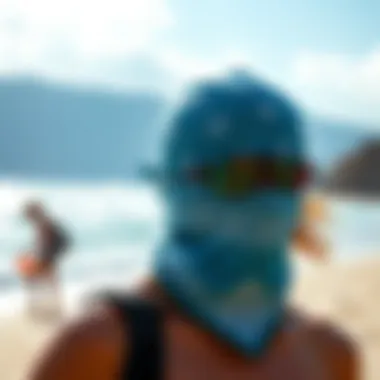
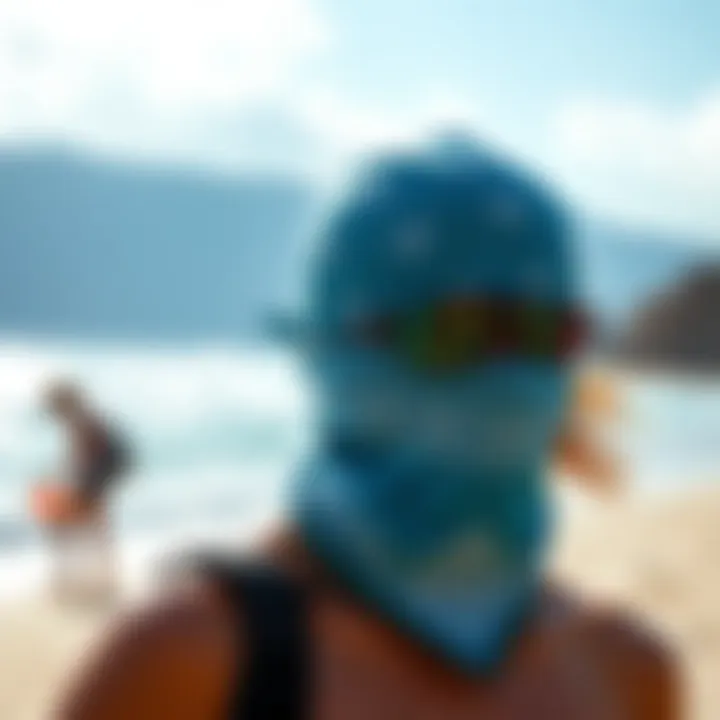
- Health Consciousness: Consumers are increasingly knowledgeable about the health risks associated with UV exposure, prompting a demand for protective gear that also aligns with their aesthetic desires.
- Sustainability: A significant shift towards eco-friendliness is influencing purchases. Consumers care about where their products come from and the impacts they have on the environment. Many are gravitating towards UV bandanas made with sustainable materials.
- Customization: More buyers are looking for personalized or limited-edition UV bandanas that reflect their individuality.
This evolving landscape forces brands to rethink design and marketing strategies, constantly aligning themselves with consumer values.
The Role of Social Media in Popularizing UV Bandanas
Social media has become a powerful tool in promoting UV bandanas, giving brands a platform to engage directly with potential customers. Through influencers and targeted advertising, awareness of these products has skyrocketed. Notable aspects of social media’s role include:
- Visual Appeal: Platforms like Instagram and TikTok showcase fashion in visual formats, helping UV bandanas capture attention through stylish imagery and innovative uses in various looks.
- Influencer Collaborations: Many influencers are not shy about endorsing UV bandanas, often featuring them in their outdoor adventures. This kind of visibility can rapidly accelerate a product’s trend status.
- User-Generated Content: Customers are encouraged to share how they style their UV bandanas, building a community around the product. It offers social proof, reinforcing brand loyalty.
"With the right visuals and testimonials, UV bandanas can go from utility products to must-have fashion items almost overnight."
Expert Opinions on UV Bandanas
In today's fashion landscape, the influence of expert opinions cannot be understated. Fashion designers, health professionals, and manufacturers play significant roles in shaping consumer perceptions about UV bandanas. Understanding their insights can illuminate the importance of these accessories, particularly as society becomes more aware of UV safety and its intersection with personal style.
Fashion Designers' Perspective
Fashion designers today aren't merely creators; they are also communicators of cultural trends and lifestyles. Many designers see UV bandanas as more than just sun protection; they are a canvas for creativity. They allow designers to merge functionality with avant-garde design. For instance, many designers are experimenting with prints, textures, and innovative patterns to make UV bandanas not just protective gear, but also a statement piece. These bands can elevate an outfit from mundane to striking, embodying the spirit of je ne sais quoi that many fashion enthusiasts seek.
"A UV bandana worn correctly can add that bit of flair to one’s look, saying both 'I care about my skin' and 'I have style.'" – Renowned Fashion Designer
The challenge for designers is to strike a balance between the essential protective qualities and an aesthetic appeal. They want consumers to wear UV bandanas with pride, promoting not just functionality but also the visuals that resonate with the wearer’s personal ethos. With patterns inspired by nature or urban environments, the options are as diverse as the individuals themselves.
Health Experts' Recommendations
Health experts emphasize the critical nature of UV protection, particularly as outdoor activities become more popular. They advise the use of UV bandanas as part of a broader sun safety strategy. Many enthusiasts underestimate ultraviolet rays’ impact, particularly on the neck and face—areas often forgotten in the quest for sun protection.
For instance, dermatologists point out that consistent use of UV bandanas can significantly reduce the risk of skin-related issues, such as sunburn and long-term effects like skin cancer. They encourage consumers to look for bandanas that meet the highest UV protection standards. Prominent health organizations, including the Skin Cancer Foundation, stress the importance of wearing these accessories in conjunction with sunscreen and protective clothing.
Experts recommend that consumers seek out UV bandanas with UPF ratings, as higher ratings typically indicate better protective capabilities. Interestingly, they also note the psychological aspects; donning stylish UV protection gear can encourage more consistent sun-safe behaviors.
Manufacturers' Insights on Future Trends
Manufacturers in the textile industry recognize that the market for UV bandanas is expanding rapidly. This surge creates opportunities for innovation in materials, manufacturing practices, and sustainability. Many are investing in R&D to develop even more effective UV-blocking fabrics that are lightweight yet durable.
Furthermore, they expect to see a continued rise in consumer demand for eco-friendly options. With an increasing number of buyers seeking products that are not just practical but also environmentally sustainable, manufacturers are exploring organic materials and processes that reduce environmental impact.
Lately, many manufacturers are introducing tech-infused bandanas, which include features such as moisture-wicking fabric and temperature control properties. These advancements suggest that UV bandanas are evolving into multifunctional accessories, catering to active lifestyles while still maintaining their primary role in sun safety.
They are keeping a close eye on trends as well, noticing how celebrity endorsements and social media have created a buzz around UV bandanas. The future looks bright for these accessories as awareness of UV protection grows and consumer preferences shift.
In summation, expert insights drive home the point that UV bandanas are at the intersection of fashion, health, and innovation. By understanding perspectives from various sectors, consumers can appreciate not just the utility of UV bandanas, but also their role in current and future fashion trends. As the dialogue between industry and consumers evolves, one thing is clear: the humble bandana has reinvented itself into a vital staple in both wardrobes and sun safety arsenals.
The Future of UV Bandanas
As fashion trends evolve, so do the functional aspects of clothing accessories. The future of UV bandanas isn’t just about looking good; it intertwines technology, consumer needs, and personal health. With the increasing awareness of UV radiation hazards, the role these pieces play in our wardrobes is set to expand. The benefits of UV bandanas stretch beyond mere aesthetics; they serve as essential tools in safeguarding skin against harmful rays while allowing for expression of personal style. Examining this section reveals several key elements, including innovations in fabric technology, the potential for new applications, and how they align with global fashion trends.
Innovations in Fabric Technology
The textile industry is no stranger to innovation, and the development of UV-blocking fabrics is taking center stage. Manufacturers are increasingly focusing on integrating advanced materials that combine functionality with sustainability. New technologies, such as specialized knitting techniques and treatments that enhance UV protection, are making their way into production.
Consider the emergence of fabrics like Coolcore or Techno-fabric, which not only block UV rays but also wick moisture away from the skin. This dual benefit makes UV bandanas particularly attractive for outdoor enthusiasts.
"Recent advancements in fabric technology represent a fusion of science and style that can redefine what we wear in the sun."
As these innovations continue to unfold, consumers can expect lighter, more breathable options that maintain their protective qualities, making them ideal for a variety of settings—from daily commutes to remote hiking excursions.
Potential for New Applications
The versatility of UV bandanas doesn't stop at fashion; there’s ample opportunity for expanding their applications. Beyond being a mere accessory, these pieces are positioned to aid individuals in numerous environments. As companies emphasize multifunctionality, creators are designing bandanas that can serve dual purposes, such as a headband or a face mask, merging sun protection with everyday usage.
We could see these bandanas being tailored for specific activities, like cycling or gardening, where elongated lengths offer coverage without compromising mobility. Additionally, the healthcare industry could witness a rise of UV bandanas designed for post-surgery patients who are at a heightened risk for UV exposure.
- Customization for specific needs:
- Adaptive designs for outdoor sports
- Medical-grade UV protection for sensitive individuals
Such innovations highlight the potential that lies in adapting fashion items for greater utility—this is where practicality meets savvy design.
The Role of UV Bandanas in Global Fashion Trends
As fashion continues to embrace sustainability and health-consciousness, UV bandanas are likely to find themselves at the intersection of these movements. With celebrities and influencers leading the charge, there's an increased dialogue around how accessories can provide both flair and functionality. Their adoption is not just a passing gimmick; rather, it reflects a broader cultural shift towards responsible fashion choices.
As a result, UV bandanas might become staple items seen alongside other sun-safe gear, such as hats and sunglasses in the coming years. Not only do they contribute to skin protection, but they can also enhance an outfit’s visual appeal, adapting to a wide spectrum of styles, from bohemian to sporty.
In summary, as we look ahead, it's clear that the future of UV bandanas is laden with possibilities. They’re not just accessories but increasingly essential components of modern wardrobes that prioritize health and style. Considering their trending popularity and potential innovations, the widespread use of UV bandanas is a forecast that seems not only possible but likely.












